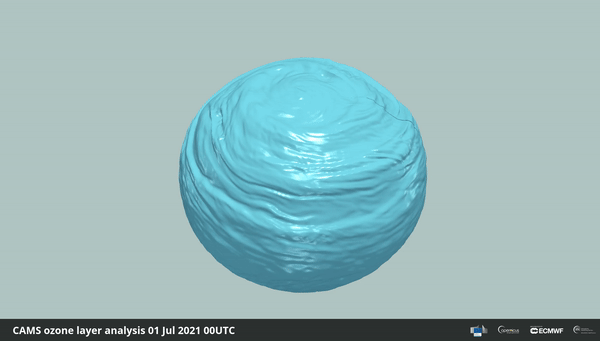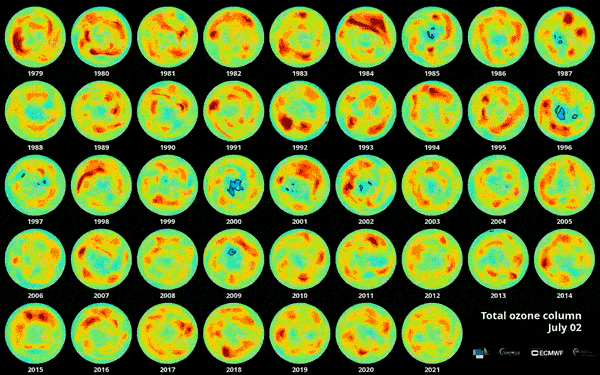This year's giant Antarctic ozone hole possibly due to climate change
This year's Antarctic ozone hole is already among the 25% largest in recorded history and is still growing.

A giant ozone hole has opened up over Antarctica this year. Already larger than the entire ice-covered continent, the ozone hole has surpassed the size of 75% of ozone holes measured since 1979 and is still growing. Scientists believe climate change might be the cause.
The Montreal Protocol, signed in 1987, is frequently described as the world's great success story in battling human-caused destruction of the environment. The agreement banned harmful chlorofluorocarbons and other substances known to destroy the protective ozone layer, which absorbs damaging ultraviolet UV radiation coming from the sun. The concentrations of the damaging substances in the atmosphere have leveled off since the protocol came into force and are slowly decreasing, providing the foundation for the layer's gradual healing. But worsening climate change is now slowing down the recovery.
"It's still a matter of research to fully understand the connection between the ozone recovery and climate change, but we know that there is a coupling between ozone depletion and temperature," Vincent-Henri Peuch, director of the European Union's Copernicus Atmosphere Monitoring Service, which released the data on Thursday (Sept. 16), told Space.com.
Related: Air pollution from reentering megaconstellation satellites could cause ozone hole 2.0
While temperatures at the planet's surface are increasing, the stratosphere, where the protective ozone shield resides, is cooling down. The stratosphere, the layer of Earth's atmosphere about 6.5 to 30 miles (10 to 50 kilometers) in altitude, is where the so-called polar stratospheric clouds form in winter. Scientists know today that these clouds provide the perfect chemical environment for the damaging chlorine and bromine-based substances to do their destructive work. They also know that the colder the temperature of the stratosphere, the more polar stratospheric clouds tend to form, Peuch said.
"Sometimes the ozone hole is small because there are no polar stratospheric clouds and sometimes, when there are many, it tends to be bigger," Peuch said. "With more polar stratospheric clouds, chlorine and other harmful substances can work more effectively and cause more damage even if their concentrations are decreasing."
When the Montreal Protocol was signed, scientists predicted that the ozone layer would fully recover by 2060, Peuch added. Recent measurements, however, suggest that this healing process is slowing down and that a full recovery could be expected no earlier than in 2070.
Breaking space news, the latest updates on rocket launches, skywatching events and more!
Climate change isn't entirely responsible; some countries continue using and releasing the banned substances illegally.
"In 2018, high levels of banned chlorofluorocarbons were detected in the atmosphere that were eventually traced to China," Peuch said. "If such illegal emissions go undetected for some time, that could really compromise the whole process because the chlorine and bromine in the atmosphere could stop levelling off and stabilize or even increase."
Peuch, however, says that the size of the ozone hole varies substantially year to year and trends are hard to pick out. This year, the ozone hole already covers an area of 8.5 to 8.8 million square miles (22 to 23 million square km), just 700,000 square miles (2 million square km) short of the 2006 record level of 9.7 million square miles (25 million square km). Peuch predicts the hole will continue to grow until early October, when temperatures in the Southern Hemisphere will start to rise.

2020 also saw a very large, and the longest lasting, ozone hole that only closed in late December. In 2019, on the other hand, the ozone hole was the smallest in recorded history.
The Copernicus Atmosphere Monitoring Service, uses data from several satellites that detect ozone in the stratosphere by measuring the passage of the ultraviolet and infrared components of sunlight through the atmosphere. The less ozone present, the more ultraviolet and infrared light gets through. Sophisticated computer models then combine the data, just like in weather forecasting.
Peuch said researchers are still trying to unpack the connection between climate phenomena experienced on Earth and the processes in the stratosphere. It is therefore impossible to say whether this year's unprecedented heatwaves in many parts of the world and the gaping ozone hole might be connected.
Follow Tereza Pultarova on Twitter @TerezaPultarova. Follow us on Twitter @Spacedotcom and on Facebook.

Tereza is a London-based science and technology journalist, aspiring fiction writer and amateur gymnast. She worked as a reporter at the Engineering and Technology magazine, freelanced for a range of publications including Live Science, Space.com, Professional Engineering, Via Satellite and Space News and served as a maternity cover science editor at the European Space Agency.
